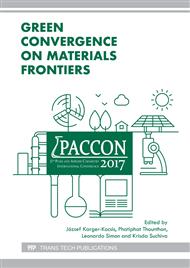[1]
W.H. De Jong, P.J.A. Borm, Drug delivery and nanoparticles: applications and hazards, Int. J. Nanomedicine. 3 (2008) 133-149.
Google Scholar
[2]
S.K. Basu, K. Kavitha, M. Rupeshkumar, Evaluation of ionotropic cross-linked chitosan/gelatin B microspheres of tramadol hydrochloride, AAPS. Pharm. Sci. Tech. 12 (2011), 28-34.
DOI: 10.1208/s12249-010-9537-2
Google Scholar
[3]
Z. Song, Q. Wang, Y. Du, Alginate/gelatin blend films and their properties for drug controlled release, J. Membr. Sci. 280 (2006), 37-44.
DOI: 10.1016/j.memsci.2006.01.002
Google Scholar
[4]
T.V.L. Hima Bindu, M. Vidyavathi, K. Kavitha, T.P. Sastry, Preparation and evaluation of ciprofloxacin loaded chitosan gelatin composite films for would healing activity, International Journal of Drug Delivery. 2 (2010) 173-182.
DOI: 10.5138/ijdd.2010.0975.0215.02027
Google Scholar
[5]
M. Cheng, J. Deng, F. Yang, Y. Gong, N. Zhao, X. Zhang, Study on physical properties and nerve cell affinity of composite films from chitosan and gelatin solutions, Biomaterials. 24 (2003) 2871-2880.
DOI: 10.1016/s0142-9612(03)00117-0
Google Scholar
[6]
S. Matiacevich, D.C. Cofré, C. Schebor, J. Enrione, Physicochemical and antimicrobial properties of bovine and salmon gelatin-chitosan films, CyTA - Journal of Food. 11 (2013) 366-378.
DOI: 10.1080/19476337.2013.773564
Google Scholar
[7]
Y. Huang, S. Onyeri, M. Siewe, A. Moshfeghian, S.V. Madihally, In vitro characterization of chitosan-gelatin scaffolds for tissue engineering, Biomaterials. 26 (2005) 7616-7627.
DOI: 10.1016/j.biomaterials.2005.05.036
Google Scholar
[8]
S. Rivero, M.A. García, A. Pinotti, Composite and bi-layer films based on gelatin and chitosan, J. Food Eng. 90 (2009) 531-539.
DOI: 10.1016/j.jfoodeng.2008.07.021
Google Scholar
[9]
X.Z. Shu, K.J. Zhu, Controlled drug release properties of ionically cross-linked chitosan beads: the influence of anion structure, Int. J. Pharm. 233 (2002) 217-225.
DOI: 10.1016/s0378-5173(01)00943-7
Google Scholar
[10]
X. Ling, Y. Zu-yu, Y. Chao, Z. Hua-yue, D. Yu-min, Swelling studies of chitosan-gelatin films cross-linked by sulfate, Wuhan University Journal of Natural Sciences. 9 (2004) 247-251.
DOI: 10.1007/bf02830611
Google Scholar
[11]
H.E. Paul, J.H. Kenyon, M.F. Paul, A.R. Borgmann, Laboratory studies with nitrofurantoin. Relationship between crystal size, urinary excretion in the rat and man, and emesis in dogs, J. Pharm. Sci. 56 (1967) 882-885.
DOI: 10.1002/jps.2600560719
Google Scholar
[12]
A.R. Borgmann, K.J. Hayes, H.E. Paul and M.F. Paul, U.S. Patent 3, 401, 221 (1968).
Google Scholar
[13]
N. Bhatt, S. Goyal, Sustained-release matrix tablets of nitrofurantoin: formulation and evaluation, Int. J. Chem. Tech. Res. 5 (2013) 491-501.
Google Scholar
[14]
G. Ertan, I. Sargullu, Y. Karasulu, K. Ercakie, T. Guneri, Sustainedrelease dosage form of nitrofurantoin. Part 1. Preparation of microcapsules and in vitro release kinetics, J. Microencapsul. 11 (1994) 127-135.
DOI: 10.3109/02652049409040443
Google Scholar
[15]
J. Liu, S.Y. Chan, P.C. Ho, Polymer-coated microparticles for the sustained release of nitrofurantoin, J. Pharm. Pharmacol. 54 (2002) 1205-1212.
DOI: 10.1211/002235702320402044
Google Scholar
[16]
S. Koprivnik, Formulation and evaluation of therapeutic soft contact lenses for controlled delivery of triamcinolone acetonide, Diplomska Naloga, University of Ljubljana, Faculty of Pharmacy, (2011).
Google Scholar
[17]
J.S. Mao, Y.L. Cui, X.H. Wang, Y. Sun, Y.J. Yin, H.M. Zhao, K.D. Yao, A preliminary study on chitosan and gelatin polyelectrolyte complex cytocompatibility by cell cycle and apoptosis analysis, Biomaterials. 25 (2004) 3973-3981.
DOI: 10.1016/j.biomaterials.2003.10.080
Google Scholar


